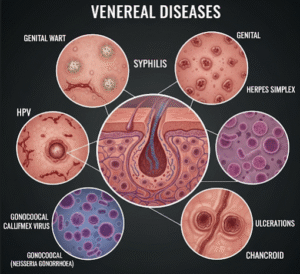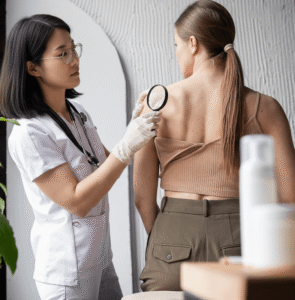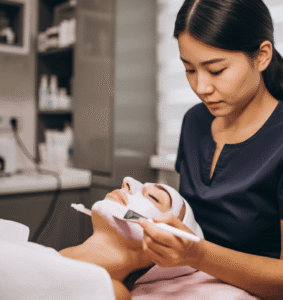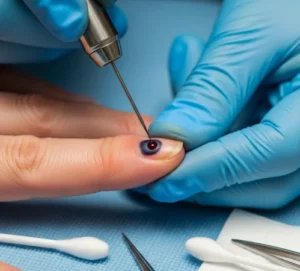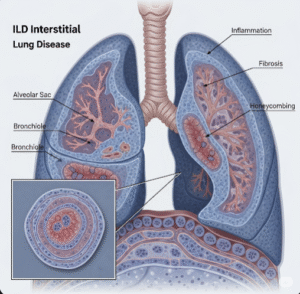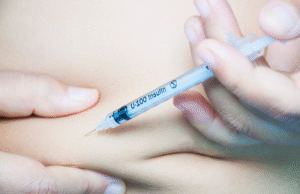A Comprehensive Guide to Skin and Care Treatment
➤ What it is
Necklace lines are the horizontal wrinkles that form across the neck, resembling jewelry lines. They are caused by:
- Repetitive neck movements (looking down at devices, posture habits),
- Aging and collagen breakdown,
- Sun damage,
- Genetic predisposition,
- Skin dehydration and lifestyle factors (smoking, poor sleep).
Laser therapy for necklace lines is a non-surgical treatment that uses light or fractional laser energy to resurface skin, stimulate collagen, and improve texture. In Korea, necklace line laser is often combined with skin boosters, RF microneedling, or fillers to achieve natural and comprehensive rejuvenation.
➤ Why it’s done
Necklace line laser treatment is performed to:
- Smooth horizontal wrinkles → reduces line depth and appearance.
- Stimulate collagen → strengthens skin and improves elasticity.
- Enhance skin texture → minimizes crepiness and roughness.
- Brighten pigmentation → reduces darkened or shadowed lines.
- Prevent deeper aging → slows progression of visible wrinkles.
- Korean Aesthetic Standards → in Korea, a smooth, youthful neck is essential for harmony with the face, making necklace line care highly popular.
➤ Alternatives
Laser treatment is powerful, but other alternatives exist:
Injectables
- Hyaluronic acid fillers → fill deep necklace lines.
- Skin boosters (PN, PDRN, exosomes) → hydrate and rejuvenate thin skin.
- PRP (platelet-rich plasma) → stimulates natural collagen.
Energy-Based Devices
- RF microneedling (Scarlet RF, INTRAcel) → tightens skin and smooths wrinkles.
- HIFU (Ulthera, Shurink) → lifts and firms deeper tissues.
Topical Skincare
- Retinoids, peptides, antioxidants for long-term collagen support.
- Sunscreens to prevent UV-related damage.
Surgical Options
- Rarely needed for horizontal lines unless combined with a neck lift for severe laxity.
Korean Cosmetic Alternatives
- Neck spa facials → hydrogel masks, brightening serums.
- LED red light therapy → boosts collagen and circulation.
- Customized cosmeceuticals → daily wrinkle prevention regimens.
➤ Preparation
Before laser treatment, preparation ensures both safety and results:
- Dermatology Consultation
- Wrinkle severity evaluated.
- Determine whether laser alone or combination therapy is best.
- Pre-Treatment Care
- Stop retinoids and exfoliants 1–2 weeks before.
- Avoid sun exposure and tanning.
- Keep neck skin moisturized.
- Lifestyle Adjustments
- Hydrate well and reduce alcohol/smoking.
- Adjust posture (limit “tech neck” strain).
- Korean Clinic Preparation
- Digital wrinkle imaging and skin analysis.
- Numbing cream or cooling masks applied before laser.
➤ How it’s Done
Necklace line laser treatment in Korea is performed using advanced fractional and resurfacing devices:
1. Types of Lasers Used
- Fractional CO₂ laser → resurfaces wrinkles, stimulates collagen, best for moderate-to-deep lines.
- Er:YAG laser → gentler resurfacing, minimal downtime.
- Pico lasers → improve pigmentation within necklace lines.
- Non-ablative fractional lasers (1550 nm, 1540 nm) → collagen stimulation with quicker recovery.
2. Procedure Steps
- Neck area cleansed and numbing cream applied.
- Laser handpiece delivers controlled beams along necklace lines.
- Microthermal zones trigger skin repair and new collagen formation.
- Session length: 20–40 minutes.
3. Number of Sessions
- Typically 3–5 sessions spaced 3–6 weeks apart.
- Improvement continues for months as collagen builds.
4. Korean Dermatology Additions
- LED therapy post-laser to soothe redness.
- Hydrogel cooling masks applied immediately after.
- Skin boosters (PN, exosomes) often injected alongside laser to accelerate healing.
➤ Recovery
Recovery varies depending on the type of laser:
- Fractional CO₂ → redness, peeling, and mild swelling for 3–7 days.
- Er:YAG or non-ablative lasers → mild redness for 1–2 days, little downtime.
- Pico lasers → minimal redness, results seen gradually.
Aftercare Instructions:
- Apply soothing ointments or creams prescribed by dermatologist.
- Avoid direct sun and wear sunscreen daily.
- Keep skin moisturized.
- Do not scratch or peel flaking skin.
Korean Recovery Practices:
- Barrier-repair creams with ceramides or hyaluronic acid.
- Brightening serums to improve pigmentation.
- Clinic-based facials after healing for long-term results.
➤ Complications
Laser treatment is generally safe, but risks may include:
- Redness and swelling (temporary).
- Pigmentation changes (especially if sun exposure occurs after treatment).
- Scarring (rare, minimized with expert technique).
- Dryness or sensitivity.
Korean clinics minimize risks by:
- Using calibrated devices with precision settings.
- Offering combination therapies for less aggressive, safer results.
- Following with LED therapy and hydration facials for recovery.
➤ Treatment Options in Korea
Korea is at the forefront of necklace line laser therapy, offering highly advanced options.
Why Korea excels:
- Cutting-edge lasers → CO₂, Er:YAG, Pico, and non-ablative fractional devices.
- Integration with injectables and skin boosters.
- Expertise in delicate neck skin treatments.
- Cosmetic culture → focus on smooth, natural results.
Unique Korean Practices:
- Combination protocols → laser + filler + skin booster for complete correction.
- LED recovery sessions included in packages.
- Neck spa facials → cooling masks, herbal compresses, and hydration.
- Cosmeceutical regimens prescribed for home maintenance.
- Medical tourism clinics → specialized neck rejuvenation programs.
✨ Final Thoughts
Necklace Line Laser in Korea is one of the most effective non-surgical treatments to smooth horizontal neck wrinkles, stimulate collagen, and rejuvenate the skin. With fractional CO₂, Er:YAG, Pico, and non-ablative lasers, combined with skin boosters, RF, and K-beauty regimens, Korean dermatologists deliver results that are both safe and natural.
By combining laser precision with holistic skincare, Korea has become a global leader in neck rejuvenation treatments, helping patients achieve youthful, smooth, and confident necklines.


